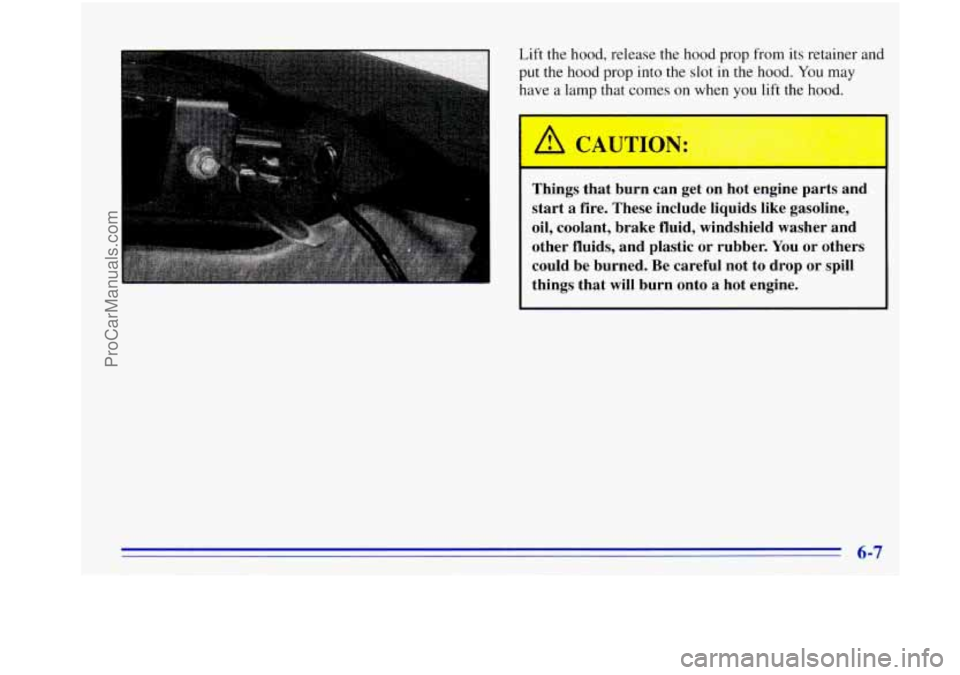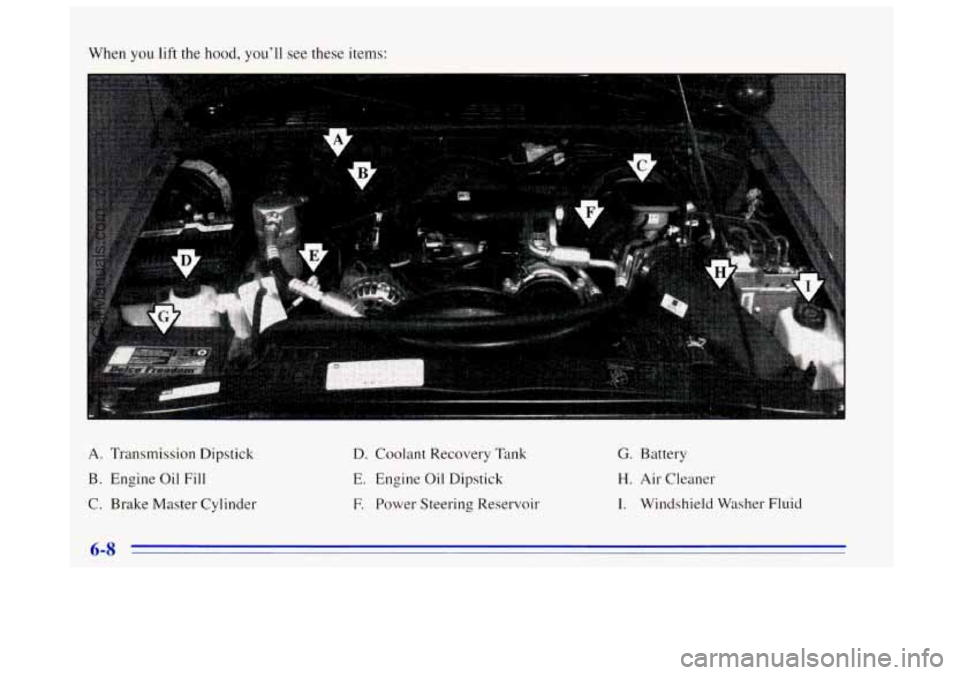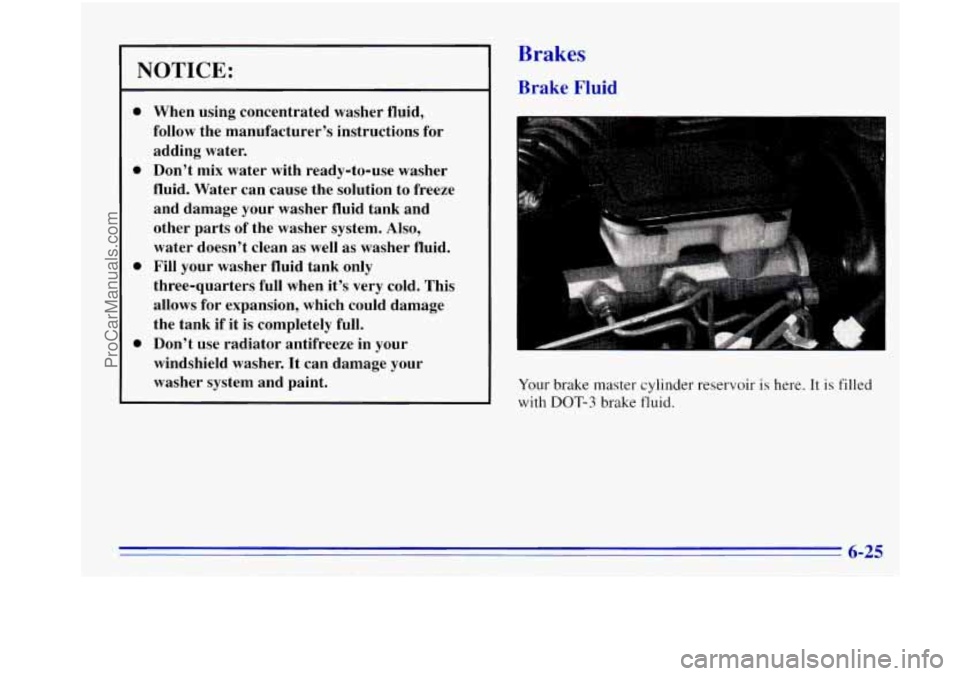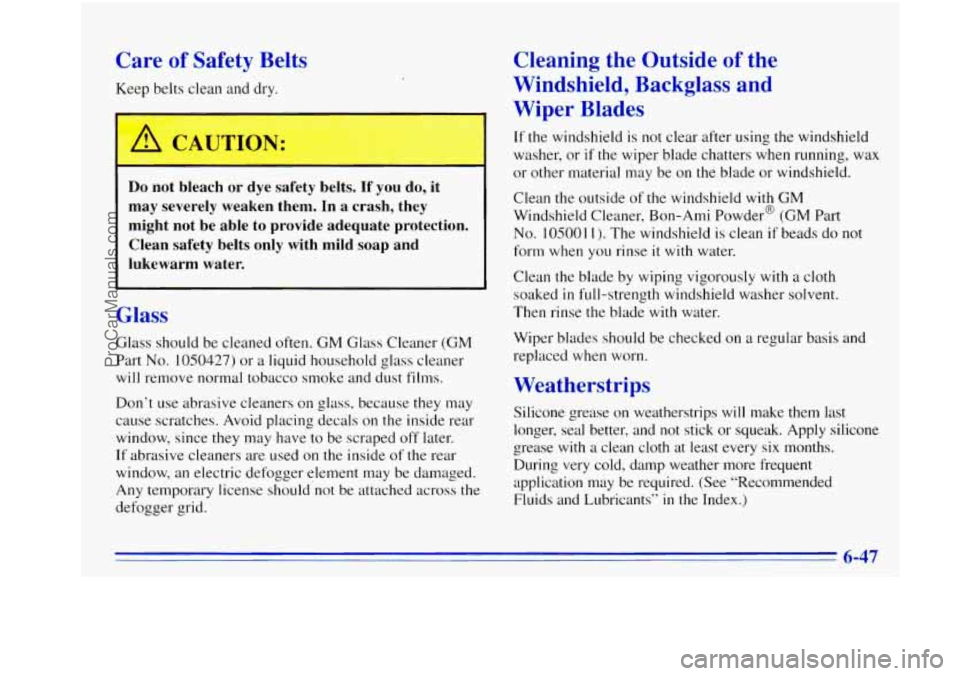washer fluid OLDSMOBILE BRAVADA 1996 Owners Manual
[x] Cancel search | Manufacturer: OLDSMOBILE, Model Year: 1996, Model line: BRAVADA, Model: OLDSMOBILE BRAVADA 1996Pages: 340, PDF Size: 17.49 MB
Page 78 of 340

Windshield Wipers
You control the windshield wipers by turning the band
with the wiper symbol
on it.
For a single wiping cycle, turn the band t.o
MIST. Hold
it there until the wipers start, then let go. The wipers will
stop after one wipe. If
you want more wipes, hold the
band on MIST longer.
You can set the wiper speed for a long or short delay
between wipes. This can be very useful
in light rain or
snow. Turn the band
to choose the delay time. The
closer to
LOW, the shorter the delay. For steady wiping at low speed,
turn the band away
from you to the LOW position. For high-speed wiping,
turn the band further, to
HIGH. To stop the wipers,
move the band
to the OFF position.
Be sure to clear ice and snow from the wiper blades
before using them. If they’re frozen to the windshield,
carefully loosen or thaw them. If your blades do becomc
worn or damaged, get new blades or blade inserts.
Windshield Washer
At the top of the multifunction lever, there’s a paddle
marked with the windshield washer symbol and
PUSH.
To spray washer fluid on the windshield, press the
paddle. The wipers will clear
the window and then
either stop
or return to your preset speed.
In freezing weather, don’t use your washer until
the windshield is warmed. Otherwise the washer
fluid can form ice on the windshield, blocking
your vision.
2-26
ProCarManuals.com
Page 79 of 340

Rear Window WasherNiper
WASH
REAR WIPER
The rear window wiper operates with a constant five
second delay when the rear wiper switch
is in the ON
position. If the rear glass is opened, the wiper arm will
automatically park on the endgate. When the glass
is
completely closed, the wiper will resume the delay mode.
To wash the window, press and hold ON. The wipers
will continue
to work after you release the switch.
Press
OFF to turn the wiper off.
The rear window washer uses the same fluid bottle as
the windshield washer. However, the rear window
washer will run out
of fluid before the windshield
washer.
If you can wash your windshield but not your
rear window, check your fluid level.
This switch is located on the instrument panel.
2-27
ProCarManuals.com
Page 157 of 340

Driving in Rain and on Wet Roads Rain and wet roads can mean driving trouble. On a wet
road, you can’t stop, accelerate or
turn as well because
your tire-to-road traction isn’t
as good as on dry roads.
And,
if your tires don’t have much tread left, you’ll get
even less traction. It’s always wise to go slower and be
cautious
if rain starts to fall while you are driving. The
surfhce may get wet suddenly when your reflexes are
tuned for driving on dry pavement.
The heavier the rain, the harder it is to see. Even
if your
windshield wiper blades are
in good shape, a heavy rain
can make
it harder to see road signs and traffic signals,
pavement markings, the edge of the road and even
people walking.
It’s wise to keep your wiping equipment
in good shape
and keep your windshield washer tank filled with
washer fluid. Replace your windshield wiper inserts
when they show signs of streaking or missing areas on
the windshield, or when strips
of rubber start to separate
from
the inserts.
ProCarManuals.com
Page 162 of 340

The exit speed is usually posted.
Reduce your speed according
to your speedometer, not
to your sense of motion. After driving for any distance
at higher speeds,
you may tend to think you are going
slower than you actually are.
Before Leaving on a Long Trip
Make sure you’re ready. Try to be well rested. If you
must start when you’re not fresh
-- such as after a day’s
work
-- don’t plan to make too many miles that first part
of the journey. Wear comfortable clothing and shoes you
can easily drive
in.
Is your vehicle ready for a long trip? If you keep it
serviced and maintained, it’s ready to go. If it needs
service, have
it done before starting out. Of course,
you’ll find experienced and able service experts in
Oldsmobile retailers all across North America. They’ll
be ready and willing to help
if you need it.
Here are some things you can check before a trip:
0
0
0
0
0
0
0
Windshield Washer Fluid: Is the reservoir full? Are
all windows clean inside and outside?
Wiper Blades: Are they in good shape?
Fuel, Engine Oil, Other Fluids: Have you checked
all levels?
Lamps: Are they all working? Are the lenses clean?
Tires: They are vitally important to a safe,
trouble-free trip.
Is the tread good enough for
long-distance driving? Are
the tires all inflated to the
recommended pressure?
Weather Forecasts: What’s the weather outlook
along your route? Should you delay your trip
a short
time
to avoid a major storm system?
Maps: Do you have up-to-date maps?
ProCarManuals.com
Page 165 of 340

Winter Driving
Here are some tips for winter driving:
0 Have your Oldsmobile in good shape for winter.
0 You may want to put winter emergency supplies in
your vehicle. Include an ice
scraper, a small brush or broom, a supply
of windshield washer fluid, a rag, some winter outer
clothing,
a small shovel, a flashlight, a red cloth and a
couple of reflective warning triangles.
And, if you will
be driving under severe conditions, include
a small bag
of sand, a piece of old carpet or
a couple of burlap bags
to help provide traction. Be sure you properly secure
these items in your vehicle.
Driving on Snow or Ice
Most of the time, those places where your tires meet the
road probably have good traction.
However,
if there is snow or ice between your tires and
the road, you can have a very slippery situation. You’ll
have a lot less traction or “grip”.and will need to be
very careful.
4-37
ProCarManuals.com
Page 219 of 340

I
Lift the hood, release the hood prop from its retainer and
put the hood prop into the slot
in the hood. You may
have a lamp that comes on when you lift the hood.
Things that burn can get on hot engine parts and
start a fire. These include liquids like gasoline,
oil, coolant, brake fluid, windshield washer and
other fluids, and plastic
or rubber. You or others
could be burned. Be careful not to drop or spill
things that will burn onto
a hot engine.
ProCarManuals.com
Page 220 of 340

When you lift the hood, you’ll see these items:
A. Transmission Dipstick
B. Engine Oil
Fill
C. Brake Master Cylinder D.
Coolant Recovery Tank
E. Engine Oil Dipstick
E Power Steering Reservoir
G. Battery
H. Air Cleaner
I. Windshield Washer Fluid
6-8
ProCarManuals.com
Page 236 of 340

you hear an unusual noise. A fluid loss in this system
could indicate a problem. Have the system inspected
and repaired.
How To Check Power Steering Fluid
When the engine compartment is cool, unscrew the cap
and wipe
the dipstick with a clean rag. Replace the cap
and completely tighten it. Then remove the cap again
and look at the fluid level on the dipstick.
The
level should be between the ADD and FULL marks.
If necessary, add only enough fluid to bring the level up
to the proper range.
What to Use
Refer to the Maintenance Schedule to determine what
kind of fluid to
use. See “Recommended Fluids and
Lubricants’’
in the Index. Always use the proper fluid.
Failure to use the proper fluid can cause leaks and
damage hoses and seals.
Windshield Washer Fluid
What to Use
When you need windshield washer fluid, be sure to read
the manufacturer’s instructions before
use. If you will be
operating your vehicle in an area where the temperature
may fall below freezing, use a fluid
that has sufficient
protection against freezing.
Adding Washer Fluid
Open the cap labeled WASHER FLUID ONLY. Add
washer fluid
until the tank is full.
6-24
ProCarManuals.com
Page 237 of 340

~~ ~ NOTICE:
0
0
0
0
When using concentrated washer fluid,
follow
the manufacturer’s instructions
for
adding water.
Don’t mix water with ready-to-use washer
fluid. Water can cause the solution to freeze
and damage your washer fluid tank and
other parts of the washer system. Also,
water doesn’t clean as well as washer fluid.
Fill your washer fluid tank only
three-quarters full when it’s very cold. This
allows for expansion, which could damage
the tank if it is completely full.
Don’t use radiator antifreeze
in your
windshield washer. It can damage your
washer system and paint.
Brakes
Brake Fluid
Your brake master cylinder reservoir is here. It is filled
with DOT-3 brake fluid.
ProCarManuals.com
Page 259 of 340

Care of Safety Belts
Keep belts clean and dry.
I
Cleaning the Outside of the
Windshield,
Backglass and
Wiper Blades
Do not bleach or dye safety belts. If you do, it
may severely weaken them. In a crash, they
might not be able to provide adequate protection.
Clean safety belts only with mild soap and
lukewarm water.
Glass
Glass should be cleaned often. GM Glass Cleaner (GM
Part
No. 1050427) or a liquid household glass cleaner
will remove normal tobacco smoke and dust films.
Don’t use abrasive cleaners on glass, because they may
cause scratches. Avoid placing decals on the inside rear
window, since they may have to be scraped off later.
If abrasive cleaners are used on the inside of the rear
window, an electric defogger element may be damaged.
Any temporary license should’not be attached across the
defogger grid. If
the windshield is not clear after using the windshield
washer, or
if the wiper blade chatters when running, wax
or other material may be on the blade or windshield.
Clean the outside of the windshield with GM
Windshield Cleaner, Bon-Ami Powder@
(GM Part
No. 10500 1 I ). The windshield is clean if beads do not
form when you rinse it with water.
Clean the blade by wiping vigorously with a cloth
soaked
in full-strength windshield washer solvent.
Then rinse
the blade with water.
Wiper blades should be checked
on a regular basis and
replaced when worn.
Weatherstrips
Silicone grease on weatherstrips will make them last
longer, seal better, and not stick or squeak. Apply silicone
grease with
a clean cloth at least every six months.
During very cold, damp weather more frequent
application may be required. (See “Recommended
Fluids and Lubricants”
in the Index.)
ProCarManuals.com